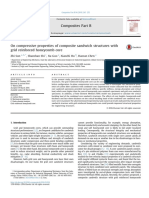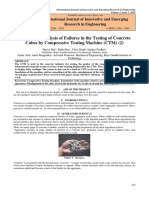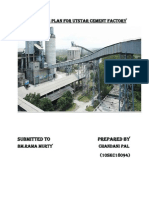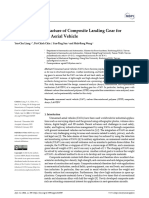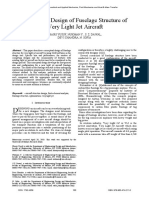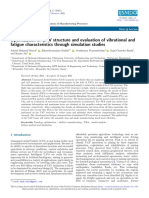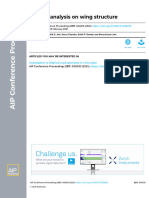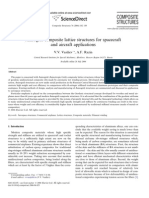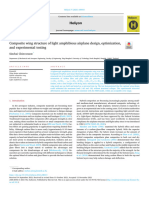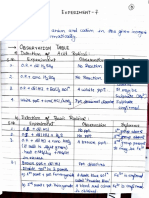Professional Documents
Culture Documents
Strength and Weight Optimization of Passenger Aircraft Fuselage Skin
Original Title
Copyright
Available Formats
Share this document
Did you find this document useful?
Is this content inappropriate?
Report this DocumentCopyright:
Available Formats
Strength and Weight Optimization of Passenger Aircraft Fuselage Skin
Copyright:
Available Formats
Volume 9, Issue 1, January 2024 International Journal of Innovative Science and Research Technology
ISSN No:-2456-2165
Strength and Weight Optimization of Passenger
Aircraft Fuselage Skin
Atharva Salunkhe1; Chetan Patil1; Harshvardhan Deshmukh1; Yash Shinde1; Krishna.B. Jadhav1*
1
Department of Aerospace Engineering, MIT Art Design and Technology University, Pune 412201, India
Abstract:- Since most of the crucial components, and high stress. Among these materials, hybrid composites,
including the front, rear, and wings, are attached to the specifically the amalgamation of carbon fiber and glass fiber
central fuselage, it plays a significant influence in the reinforced with advanced epoxy resins, have emerged as
design of aircraft fuselages, leading to increased payload promising avenues for enhancing the structural integrity and
and improved performance. So, the load applied to the performance of aircraft fuselages.
part is transferred to the central fuselage part. The
primary objective of our study is to optimize the fuselage This study is geared towards exploring and optimizing
skin to withstand varying loads, with a particular focus the structural composition of aircraft fuselages by leveraging
on the central fuselage part where the load is the interdependent properties of hybrid composites. Through
transferred. This central fuselage plays a pivotal role in the synergistic combination of the superior strength and
the overall weight distribution of the aircraft. To achieve stiffness of carbon fiber with the impact resistance and cost-
weight reduction, we employ material optimization effectiveness of glass fiber, this research endeavors to create
techniques, specifically comparing aluminium alloy with a material composition that transcends the limitations of
hybrid composite materials. individual constituents. The incorporation of high-
performance epoxy resins further bolsters the structural
Material optimization involves a comprehensive characteristics, imparting resilience and stability under
comparison between aluminium alloy and hybrid diverse operating conditions.
composite materials, wherein composite laminates,
comprising carbon fiber, glass fiber, and Hexply 8552, The significance of this investigation lies in its
are applied over the fuselage skin. This approach allows potential to yield a fuselage structure that not only meets but
us to analyze both the physical and structural properties exceeds the rigorous demands of the aviation industry. The
of the fuselage. pursuit of an optimized fuselage design using hybrid
composites addresses multifaceted objectives, including
Various structural analyses, including Shear Test, weight reduction, enhanced fuel efficiency, improved
Bending Test, Fatigue Test, Tensile Test, and mechanical properties, and elevated safety standards, all
Compression Test, have been meticulously conducted while concurrently upholding passenger comfort and
using ANSYS WORKBENCH Software. Boundary operational economy.
conditions are established according to specific
requirements. The results unequivocally demonstrate II. LITERATURE REVIEW
that the hybrid composite material exhibits superior
properties compared to conventional aluminium alloy. Penn State Harrisburg, PA, USA, Athreya Nagesh*,
This includes enhanced performance and achieved Ola Rashwan, Maamoun Abu-Ayyad, Published November
material optimization, ultimately impacting the total 2018,[1] "Composite Aeroplane Fuselage Optimisation for
weight of the aircraft. Optimal Structural Integrity" Rather than using AL alloys
for the fuselage skin, this study used finite element analysis
Keywords:- Material Optimization, Aluminium Alloy, to find the optimal composite laminate combination..R
Carbon Fibre, Glass Fibre, Hexply 8552, Hybrid Composite Sreenivasa, C.S. Venkatesha, Jain Institute of Technology,
Materials. Karnataka, India,[2] “Study The Effect Of Crack on Aircraft
Fuselage Skin Panel Under Fatigue Loading Conditions”
I. INTRODUCTION .This article investigates the effect of fatigue loading
conditions on fuselage skin panel cracks. According to the
In the contemporary landscape of aviation, there has fatigue analysis results, the uncracked model has a life under
been substantial progress in the design and construction of the specified parameters since it can sustain load cycles. [3]
aircraft, with a primary focus on achieving an optimal K Vamssi Venugopal, I. R. K. Raju, “Design and
balance between performance, durability, and fuel Optimization of Aircraft Fuselage under Dynamic Response
efficiency. The aircraft fuselage, serving as the fundamental by Finite Element Analysis” This study presents some
framework of aerial transportation, plays a critical role in essential components of the design and analysis of airplane
influencing these key factors. In recent times, the structures. The selection of materials, the structure's design,
introduction of composite materials has brought about a the evaluation of loads, and the influence of dynamic loads
paradigm shift in aircraft design, offering exceptional are some of these essential components. It has been
strength-to-weight ratios and resilience to fatigue, corrosion, observed that metal weighs more than composite fiber. After
IJISRT24JAN1593 www.ijisrt.com 2356
Volume 9, Issue 1, January 2024 International Journal of Innovative Science and Research Technology
ISSN No:-2456-2165
material optimization, the construction is subjected to both The dimensions of the fuselage are as follows:
static and dynamic load conditions.[4] Y Santosh, Prashanth
Bhatti, “Structural and Modal Analysis of Fuselage” the Table 1: Dimensions of fuselage model
process of conceptually designing an airplane's fuselage Parameter Value (mm)
structure using CAD software. These findings demonstrate Outer Diameter 5972
the superiority of the novel construction over the T-shaped Inner Diameter 5970
cross section.[5] Sowmya R, Sreenivasa R, Kallesh SS, Fuselage Length 7482
“Design Optimization If Airframe in Aircraft Fuselage Window Width – 270
Structure under Static Loading Conditions” The current Length - 518
article explains how to identify which airframe designs can
withstand static loading circumstances with the least amount B. Meshing
of deflection by optimising the design of fuselage Following the design phase, meshing was conducted in
components that include airframes. To obtain correct results, Ansys, a critical step in Finite Element Analysis (FEA)
each model's boundary conditions are adjusted. 2024-T351 simulation. Meshing involves transforming amorphous
Aluminum Alloy is used in the fuselage structure. After shapes into discrete "elements" or well-defined volumes.
comparing the optimized models, it is found that Case 6 has This step is essential for accurate simulation results. The
less produced stress (118 Mpa) while Case 7's optimised mesh is composed of elements with nodes, the number and
fuselage model has a 2.5mm deflection.[6] Mukhopadhyay, distribution of which depend on the type of element chosen.
Vivek Sorokach, Michael R, 2015“Utilization of Advanced Nodes represent coordinates in space and define the
Composites in Fuselage Structures of Commercial Aircraft” geometry's shape, playing a pivotal role in the accuracy of
Through a study, the knowledge and technologies needed to the FEA simulation.
make it possible to employ advanced composites in the
future to produce large transport aircraft fuselage structures
were identified.
METHODOLOGY
The project strives to optimize fuselage skin through
composite materials, utilizing Ansys software. The fuselage
model, referencing the Airbus A-350, was constructed in the
Discovery module of Ansys. Subsequently, the composite
skin design is being developed in the ACP module of Ansys,
followed by the execution of various structural tests within
the Ansys platform. Fig. 2: Meshed model of fuselage
C. Selection of materials
A. Fuselage model
The 3D model of the fuselage was created using the After meshing, selecting the appropriate materials for
the fuselage skin becomes a critical task, considering all
Discovery module of Ansys. This product simulation
parameters affecting the aircraft's performance. The chosen
software enables efficient model preparation and the
exploration of design variations with real-time interactivity. materials for this purpose include Carbon fiber, Glass fiber,
The design process was informed by the Airbus A-350 as a and HexPly 8552 Epoxy matrix (resin). Carbon fiber,
reference, chosen for its remarkable fuel efficiency and primarily composed of carbon atoms, is renowned for its
exceptional comfort levels. Ansys Discovery 3D played a exceptional strength, flexibility, and high tensile strength.
pivotal role in rapidly generating models for simulation and Additionally, it offers high stiffness and chemical resistance.
Glass fiber, on the other hand, is widely used in Polymeric
experimenting with various design concepts.
Matrix Composites (PMCs) due to its excellent tensile
strength and stiffness properties. By carefully considering
these material characteristics, we aim to ensure optimal
performance and durability of the fuselage skin.Glass fibers
offer cost-effectiveness, chemical resistance, high tensile
strength, and superior insulation. The high-performance
epoxy matrix HexPly 8552 is specifically designed for
critical use in major aircraft structures, ensuring durability
and optimal performance. For a variety of uses, it
demonstrates good damage tolerance and impact resistance.
HexPly 8552 is a resilient epoxy resin system, amine-cured,
Fig. 1: 3D Model of Fuselage and available with woven or unidirectional carbon or glass
fiber options.
IJISRT24JAN1593 www.ijisrt.com 2357
Volume 9, Issue 1, January 2024 International Journal of Innovative Science and Research Technology
ISSN No:-2456-2165
Table 2: Properties of composites
Sr. No. Properties Carbon fiber Glass fiber HexPly 8552
(395 GPa) (S Glass) Epoxy matrix
1 Density (kg/m3) 1750 1857 1301
2 Thermal Conductivity(W/m.k) 6 0.04 low
3 Tensile Strength (MPa) 3000-7000 2000-4000 60-120
4 Young's Modulus (GPa) 230 70-80 2.5-5
5 Comp. Strength (MPa) 3000 3000-4000 80-150
6 Flexural Strength (MPa) 3000-7000 1000-2000 80-150
D. Design of composite fuselage skin
The fuselage skin design was accomplished using the of the fuselage in opposite directions to the center. The
ACP module of Ansys. Ansys Composite PrepPost (ACP) is applied force had a magnitude of 10000 N.
an integrated tool within the Workbench platform
specifically designed for modeling composite laminates. C. Compression Test
ACP facilitates the precise definition and selection of In a compression test, a mechanical device is utilized
material data, allowing for accurate specification of stacking to assess how a product or material responds to applied
sequences throughout the entire structure during the pre- forces. In this context, the fuselage skin serves as the test
processing phase. specimen. The test is conducted by applying forces of equal
magnitude at the ends of the fuselage in the same direction
towards the center. The applied force has a magnitude of
10000 N.
D. Bending Test
This rapid and cost-effective qualitative test assesses
the ductility, bend strength, fracture strength, and resistance
to fracture of a material. The test involves fixing both ends
of the fuselage and applying loads to the top surface. The
magnitude of the applied load is 10000 N.
Fig. 3: Composition and fibre orientation E. Shear Test
Shear testing involves subjecting a test sample to stress
III. STRUCTURAL TESTS AND BOUNDARY to induce sliding failure along a plane parallel to the applied
forces. Understanding how a material responds to forces
CONDITIONS
acting parallel to its surface is crucial for assessing structural
integrity. In the case of fuselage testing, one end is fixed,
Various static structural tests were conducted in Ansys
and a tangential load is applied to the skin in the opposite
software to analyze stress, strain, and deformation under
different loading scenarios. This process aids in identifying direction. The magnitude of the applied load is 10000 N.
weak points with low strength and durability during the
design stage. Initial tests were performed on conventional IV. RESULTS AND DISCUSSIONS
materials, followed by evaluations on our designed
composite material. Following the design of the composite fuselage skin, a
comprehensive set of static structural analyses, including
The tests which have been performed are: Fatigue, Compressive, Tensile, Shear, and Bending tests,
were conducted. For each test, two key parameters, namely
A. Fatigue Test Stress and Strain, were considered. This approach facilitates
Fatigue tests were conducted to determine the number a meaningful comparison between the performance of the
of load cycles until failure and assess the material's stiffness composite fuselage and the conventional Aluminium alloy
and strength degradation under repeated loading. The tests fuselage. The analysis aims to provide insights into the
involved applying pressure at the top and bottom of the structural behavior and performance differences between the
two materials under various loading conditions.
fuselage in an outward orientation, with fixed supports at the
right and left ends. The magnitude of the applied pressure
was 20000 Pa. A. Fatigue test
B. Tensile Test Life cycle
Tensile testing is a destructive method employed to The life cycle of the Al alloy fuselage is 10^8.
measure the ductility, yield strength, and tensile strength of The fuselage of the hybrid composite has 10^10 life
metallic materials. This technique involves applying force to cycles.
break a composite or plastic specimen and observing the
elongation before failure. In this study, tensile testing was
performed by applying forces of equal magnitude at the ends
IJISRT24JAN1593 www.ijisrt.com 2358
Volume 9, Issue 1, January 2024 International Journal of Innovative Science and Research Technology
ISSN No:-2456-2165
Fig. 7: Al alloy fuselage
Fig. 4: Life cycle of the fuselage in Fatigue test
Stress
In an alloy fuselage, the highest equivalent stress created
during a fatigue test is 2.8*10^6 Pa.
In a fatigue test, the hybrid composite fuselage's
maximum equivalent stress was 4.1*10^6 Pa.
Fig. 8: Composite fuselage
B. Bending Test
Stress
In a bending test, the highest equivalent stress generated
in an aluminum alloy fuselage is 2.9*10^5 Pa.
In a bending test, the hybrid composite fuselage's
maximum equivalent stress is 3.5*10^5 Pa.
Fig. 5: Al alloy fuselage
Fig. 9: Al alloy Fuselage
Fig. 6: Composite fuselage
Strain
The highest strain that the fatigue test can create in an
aluminium alloy fuselage is 0.00048.
5.5*10^-5 is the strain that the fatigue test of the hybrid
Fig. 10: Composite Fuselage
composite fuselage causes.
IJISRT24JAN1593 www.ijisrt.com 2359
Volume 9, Issue 1, January 2024 International Journal of Innovative Science and Research Technology
ISSN No:-2456-2165
Strain
In a bending test, the Al alloy fuselage experiences a
maximum strain of 3.4*10^-5.
The hybrid composite fuselage experiences a maximum
strain of 4.9*10^-6 during the bending test.
Fig. 14: Composite Fuselage
Strain
The Al alloy fuselage experiences a maximum strain of
1.3*10^-6 during the compression test.
Fig. 11: Al Alloy Fuselage 2.2*10^-7 is the maximum strain that a compression test
on a hybrid composite fuselage may create.
Fig. 12: Composite Fuselage
Fig. 15: Al alloy Fuselage
C. Compression Test
Stress
In a compression test, the maximum equivalent stress
generated in the Al alloy fuselage is 15413 Pa.
In a compression test, the hybrid composite fuselage had
a maximum equivalent stress of 20897 Pa.
Fig. 16: Composite Fuselage
D. Shear Test
Stress
The highest comparable stress generated in the Al alloy
fuselage during the shear test is 1.26*10^5 Pa.
Fig. 13: AL Alloy Fuselage In a shear test, the hybrid composite fuselage's maximum
equivalent stress is 1.28*10^5 Pa.
IJISRT24JAN1593 www.ijisrt.com 2360
Volume 9, Issue 1, January 2024 International Journal of Innovative Science and Research Technology
ISSN No:-2456-2165
E. Tensile Test
Stress
In an Al alloy fuselage, the maximum equivalent stress
produced during a tensile test is 15413 Pa.
The hybrid composite fuselage's highest equivalent
stress during the tensile test was 20897 Pa.
Fig. 17: AL Alloy Fuselage
Fig. 21: Al Alloy Fuselage
Fig. 18: Composite Fuselage
Strain
In a shear test, the highest strain caused in the Al alloy
fuselage is 1.6*10^-5.
The hybrid composite fuselage experiences a maximum
strain of 1.7*10^-6 during the shear test.
Fig. 22: Composite Fuselage
Strain
The Al alloy fuselage experiences a maximum strain of
1.3*10^-6 during the Tensile Test.
2.2*10^-7 is the maximum strain that can be created in
the hybrid composite fuselage during a tensile test.
Fig. 19: Al alloy Fuselage
Fig. 23: Al Alloy Fuselage
Fig. 20: Composite Fuselage
IJISRT24JAN1593 www.ijisrt.com 2361
Volume 9, Issue 1, January 2024 International Journal of Innovative Science and Research Technology
ISSN No:-2456-2165
[3]. Bauman Moscow State Technical University
(BMSTU), Tun Lin Htet, 105005, Russia “Structural
Analysis and Topology Design Optimization of Load
Bearing Aircraft Fuselage Structure” 2020.
[4]. K Vamssi Venugopal, I. R. K. Raju, Department of
Mechanical Engineering, Chaitanya Engineering
College, Visakhapatnam, “Design and Improvement of
the Aircraft Fuselage Using Finite Element Analysis
under Dynamic Response” 2018
[5]. Y Santosh, Prashanth Bhatti, Department of
Mechanical Engineering,MLR Institute of
Fig. 24: Composite Fuselage Technology,rabad, “Structural and Modal Analysis of
Fuselage” 2019
F. Weight analysis [6]. Sowmya R, Sreenivasa R, and Kallesh SS, University
Masses of the Al and hybrid composite skin fuselages BDT College of Engineering, Davanagere, Karnataka,
are 22356.94 kg and 12438.73 kg, respectively. Department of Mechanical Engineering, “Design
Optimization If Airframe In Aircraft Fuselage
Weight reduction in the fuselage skin is 44.36%.
Structure under Static Loading Conditions” 2016
[7]. Mukhopadhyay, Vivek Sorokach, Michael
V. CONCLUSION ANDFUTURE SCOPE
R,“Utilization of Advanced Composites in Fuselage
Structures of Commercial Aircraft” 2015
After conducting structural tests, including Fatigue,
[8]. H Sankara Subramanian, B Ravi Kumar, and R
Tensile, Bending, Compressive, and Shear tests on the
Abhishek from SASTRA University's School of
fuselage skin models made from conventional material
Mechanical Engineering in Tamil Nadu, “Fatigue
(Aluminium alloy) and modern material (Hybrid
Analysis and Design Optimization Of Aircraft Central
Composite with Carbon fiber, Hexply, and Glass fiber),
Fuselage” 2017
it was observed that the performance of the fuselage skin
[9]. Aditya Milind Dandekar, The University of Texas,
made from the composite materials surpassed that of the
Arlington, “Thesis on Finite Element Analysis Of
Aluminium alloy. The combination of Carbon fiber,
Composite Aircraft Fuselage Frame” May 2013
Hexply, and Glass fiber demonstrated superior
[10]. Osvaldo M. Querin, University of Leeds, School of
performance across these tests compared to the
Mechanical Engineering, UK, Topology and
traditional Aluminium alloy.
Parametric Optimization of a Lattice Composite
The fatigue test revealed that the Aluminum alloy Fuselage Structure” 2015
fuselage exhibited premature failure compared to the [11]. A. Ramesh Kumar, S. R. Balakrishnan and S. Balaji,
composite fuselage. Consequently, the composite “Design of an Aircraft Wing Structure for Static
fuselage demonstrated superior resistance to cyclic Analysis and Fatigue Life prediction”. International
loads, highlighting its enhanced durability. Journal of Engineering Research &
In Tensile, Compressive, Bending, and Shear tests, the Technology(IJERT), l2(5), 1154–1158, 2013.DOI
Hybrid Composite fuselage exhibited higher stress than 10.1088/1757-899X/225/1/012031
the Al alloy fuselage, indicating superior strength and [12]. P. Srinivasa Rao, Varun Potty, Sohan Angelo, and
structural properties. Srinivas G,“Recent Developments of an Aircraft
In all tests, the Hybrid Composite skin fuselage Fuselage along Theoretical, Experimental and
demonstrated lower strain compared to the Al alloy Numerical Approach - A Review”, December 2019,
fuselage skin. This signifies greater resistance to Universal Journal of Mechanical Engineering,
deformation in Tensile, Compressive, Bending, and 7(6A):21-28, DOI:10.13189/ujme.2019.071403.
Shear tests for the Hybrid Composite material. [13]. K. Vamssi Venugopal, R. K. Raju “Design
Beside the Structural advantages, the use of composite Optimization of Aircraft Fuselage Under Dynamic
skin fuselage reduces the weight of the skin by 44.36 % Response by Using Finite Element Analysis”,
which in return is a significant advantage when it comes November 9-15, 2018,IMECE2018., Pittsburgh, PA,
to the fuel consumption. USA
[14]. Vankan, W.J., Maas, R., and Grihon, S,”Efficient
REFERENCES optimisation of large aircraft fuselage structures”,27
January 2016.,The Aeronautical Journal , Volume 118
[1]. Athreya Nagesh*, Ma'moun Abu-Ayyad, Ola , Issue 1199
Rashwan, Penn State Harrisburg, Pennsylvania, USA, ,January2014,pp.315DOI:https://doi.org/10.1017/S000
“Optimization of Composite Airplane Fuselage 1924000008915
Optimum Structural Integrity'' Published 2017. [15]. Grigoriou, K. and Mouritz, A. "Comparative assessment of
[2]. R Sreenivasa, C.S. Venkatesha, Jain Institute of the fire structural performance of carbon-epoxy composite
Technology, Karnataka, India,“Study The Effect Of and aluminum alloy used in aerospace structures",
Crack on Aircraft Fuselage Skin Panel Under Fatigue Materials & Design, vol. 108, pp. 699-706, 2016.
LoadingConditions” 2015
IJISRT24JAN1593 www.ijisrt.com 2362
You might also like
- Conceptual Design of Fuselage StructureDocument7 pagesConceptual Design of Fuselage StructurefiemsabyasachiNo ratings yet
- Structural Analysis of Spar Madeup of Carbon Fibre Composite MaterialDocument6 pagesStructural Analysis of Spar Madeup of Carbon Fibre Composite MaterialVarunNo ratings yet
- C4M Mivan FormworkDocument3 pagesC4M Mivan Formworkmanohar reddyNo ratings yet
- Structural Analysis of Landing Strut Madeup of Carbon Fibre Composite MaterialDocument7 pagesStructural Analysis of Landing Strut Madeup of Carbon Fibre Composite MaterialMihaela NastaseNo ratings yet
- Structural Analysis of Aircraft Wing J Nose Panel Using Mono and Multi Core Composite MaterialsDocument6 pagesStructural Analysis of Aircraft Wing J Nose Panel Using Mono and Multi Core Composite MaterialsstaedtlerpNo ratings yet
- Fuselage Design For Stress Caused Due To Wing at Various Load ConditionsDocument48 pagesFuselage Design For Stress Caused Due To Wing at Various Load ConditionsSri Tech Engineering100% (1)
- Composites Part B: Zhi Sun, Shanshan Shi, Xu Guo, Xiaozhi Hu, Haoran ChenDocument8 pagesComposites Part B: Zhi Sun, Shanshan Shi, Xu Guo, Xiaozhi Hu, Haoran ChenPaulo UtargNo ratings yet
- Landing Gear Articolo Stress - 2 PDFDocument9 pagesLanding Gear Articolo Stress - 2 PDFAB1984No ratings yet
- METHOD STATEMENT Gypsum Board Ceiling Gypsum Partitions Ceiling TilesDocument10 pagesMETHOD STATEMENT Gypsum Board Ceiling Gypsum Partitions Ceiling TilesHARISH ROHANNo ratings yet
- GBT 14976-2012 English VersionDocument21 pagesGBT 14976-2012 English VersionNguyễn Xuân TrườngNo ratings yet
- Brief History of ChemistryDocument13 pagesBrief History of Chemistryteacher zaneNo ratings yet
- Cube Failure ReportDocument15 pagesCube Failure ReportVenu PrasadNo ratings yet
- Dairy Products - Outside of The Pipe Sanitary Design ChecklistDocument8 pagesDairy Products - Outside of The Pipe Sanitary Design ChecklistKbmuthukumara SaamiNo ratings yet
- Hybrid Ship Hulls: Engineering Design RationalesFrom EverandHybrid Ship Hulls: Engineering Design RationalesRating: 4.5 out of 5 stars4.5/5 (3)
- Business Plan For Utstar Cement FactoryDocument8 pagesBusiness Plan For Utstar Cement Factoryravi818780% (5)
- Advantages of Composite Materials in Aircraft Structures: Muniyasamy Kalanchiam, and Moorthy ChinnasamyDocument5 pagesAdvantages of Composite Materials in Aircraft Structures: Muniyasamy Kalanchiam, and Moorthy ChinnasamyArcLat SolutionsNo ratings yet
- Advantages of Composite Materials in Aircraft Structures: Muniyasamy Kalanchiam, and Moorthy ChinnasamyDocument5 pagesAdvantages of Composite Materials in Aircraft Structures: Muniyasamy Kalanchiam, and Moorthy ChinnasamyJules NanaNo ratings yet
- Composite Structures: Zhao Liu, Jiahai Lu, Ping ZhuDocument14 pagesComposite Structures: Zhao Liu, Jiahai Lu, Ping ZhuAkshay bypNo ratings yet
- Optimization of Wing Rib Configurations For Improved Aerodynamic Performance A Computational StudyDocument12 pagesOptimization of Wing Rib Configurations For Improved Aerodynamic Performance A Computational StudyIJRASETPublicationsNo ratings yet
- Engineering Science and Technology, An International JournalDocument11 pagesEngineering Science and Technology, An International JournalLorenzo AltonagaNo ratings yet
- Applsci 11 00509Document12 pagesApplsci 11 00509proengineer415No ratings yet
- Static Analysis of Helicopter Skid Landing Gear Made of Composite MaterialsDocument9 pagesStatic Analysis of Helicopter Skid Landing Gear Made of Composite MaterialsДмитрий ДмитренкоNo ratings yet
- JAME202201 A Study On Aircraft Structure and Application of Static ForceDocument7 pagesJAME202201 A Study On Aircraft Structure and Application of Static ForceVinod Kumar sNo ratings yet
- Structure For Helicopter ApplicationDocument19 pagesStructure For Helicopter ApplicationJan ScarNo ratings yet
- Design, Static Structural and Modal Analysis of Aircraft Wing (Naca 4412) Using Anasys Workbench 14.5Document11 pagesDesign, Static Structural and Modal Analysis of Aircraft Wing (Naca 4412) Using Anasys Workbench 14.5Deepika PandeyNo ratings yet
- Reliability-Based Design Optimization For Aerospace and Automotive StructuresDocument13 pagesReliability-Based Design Optimization For Aerospace and Automotive StructureswhyeoNo ratings yet
- Design and Static Testing of Wing Structure of A CDocument6 pagesDesign and Static Testing of Wing Structure of A Cbixo20No ratings yet
- Conceptual Design of Fuselage StructureDocument7 pagesConceptual Design of Fuselage StructuredharmonNo ratings yet
- Explicit Dynamics Crash Analysis of CarDocument8 pagesExplicit Dynamics Crash Analysis of Caruday chavanNo ratings yet
- Light-Weighting in Aerospace Component and System Design: Propulsion and Power ResearchDocument17 pagesLight-Weighting in Aerospace Component and System Design: Propulsion and Power ResearchArcLat SolutionsNo ratings yet
- Ramesh 2021 IOP Conf. Ser. Mater. Sci. Eng. 1017 012032Document10 pagesRamesh 2021 IOP Conf. Ser. Mater. Sci. Eng. 1017 012032OKA FATRANo ratings yet
- Design and Analysis of A Tail Sitter (VTOL) UAV Composite WingDocument11 pagesDesign and Analysis of A Tail Sitter (VTOL) UAV Composite WingSidi Moulaye SidneNo ratings yet
- Analisis Lineal y de FatigaDocument10 pagesAnalisis Lineal y de FatigaFranco AlberiNo ratings yet
- Experimental Investigation of The Crashworthiness Performance of Laminated Composites Using Plastic Bike's Wind Shield and Woven Carbon Fiber MatDocument11 pagesExperimental Investigation of The Crashworthiness Performance of Laminated Composites Using Plastic Bike's Wind Shield and Woven Carbon Fiber MatAbhijeet SableNo ratings yet
- 1 s2.0 S2214785322006290 MainDocument9 pages1 s2.0 S2214785322006290 MainmaddilahariniNo ratings yet
- SM Do 210080Document8 pagesSM Do 2100805415 Karim Aly HassanNo ratings yet
- Structural Analysis of Landing Strut Madeup of Carbon Fibre Composite MaterialDocument5 pagesStructural Analysis of Landing Strut Madeup of Carbon Fibre Composite MaterialДмитрий ДмитренкоNo ratings yet
- Actuators 08 00042 With CoverDocument17 pagesActuators 08 00042 With CovergauthamkashyapNo ratings yet
- 1 s2.0 S1526612518309605 MainDocument30 pages1 s2.0 S1526612518309605 MainAHMED SAMIR ALEMDARNo ratings yet
- Manufacturing of A Landing Gear Using Composite Materials For An Aerial TargetDocument11 pagesManufacturing of A Landing Gear Using Composite Materials For An Aerial TargetSabih Ahmad KhanNo ratings yet
- Shankar 2021Document9 pagesShankar 2021João OtávioNo ratings yet
- Design and Analysis of Steel Leaf Spring and Composite Leaf Spring Using Finite Element Method ApproachDocument10 pagesDesign and Analysis of Steel Leaf Spring and Composite Leaf Spring Using Finite Element Method ApproachIJRASETPublicationsNo ratings yet
- Composite Monocoque SolarDocument11 pagesComposite Monocoque SolarMuhammad SaalihNo ratings yet
- Anisogrid Composite Lattice Structures - 2006Document8 pagesAnisogrid Composite Lattice Structures - 2006smack_D0% (1)
- Composite Wing Structure of Light Amphibious Airplane Design Opti - 2021 - HeliDocument15 pagesComposite Wing Structure of Light Amphibious Airplane Design Opti - 2021 - Helipo hongNo ratings yet
- A Mathematical Formulation and SolutionDocument10 pagesA Mathematical Formulation and SolutionSab-Win DamadNo ratings yet
- Experimental Investigation of The Crashworthiness Performance of Laminated Composites Using Plastic-Fiber Wind Shield and Carbon FiberDocument10 pagesExperimental Investigation of The Crashworthiness Performance of Laminated Composites Using Plastic-Fiber Wind Shield and Carbon FiberAbhijeet SableNo ratings yet
- Parametric CAD Modelling of Aircraft Wings For FEA Vibration AnalysisDocument12 pagesParametric CAD Modelling of Aircraft Wings For FEA Vibration AnalysisAmitejNo ratings yet
- Linear Static and Fatigue Analysis of Nose Landing Gear For Trainer Aircraft Gowda11Document11 pagesLinear Static and Fatigue Analysis of Nose Landing Gear For Trainer Aircraft Gowda11Umesh SainiNo ratings yet
- Design and Optimization of Bulkhead Laminated With Palmyra and Epoxy Composite Materials Using FemDocument6 pagesDesign and Optimization of Bulkhead Laminated With Palmyra and Epoxy Composite Materials Using FemVadivel AeroNo ratings yet
- HPSM04005FUDocument10 pagesHPSM04005FUcemyeniceliNo ratings yet
- Materials and Design: Jin Zhang, Peter Supernak, Simon Mueller-Alander, Chun H. WangDocument7 pagesMaterials and Design: Jin Zhang, Peter Supernak, Simon Mueller-Alander, Chun H. WangDiamoundDomeProgram R&DNo ratings yet
- Wing Spar of CompositesDocument5 pagesWing Spar of CompositesArcLat SolutionsNo ratings yet
- A Review: Aeronautical Components and Systems Should Have Their Weight Reduced Throughout The Design ProcessDocument5 pagesA Review: Aeronautical Components and Systems Should Have Their Weight Reduced Throughout The Design ProcessMonika GuptaNo ratings yet
- Fiber Metal Laminates An Advanced Material For Future AircraftDocument11 pagesFiber Metal Laminates An Advanced Material For Future AircraftSharamito AkaritoNo ratings yet
- GansDocument9 pagesGansganesh_the_aviatorNo ratings yet
- Ajme 5 4 2Document11 pagesAjme 5 4 2PankajNo ratings yet
- Asri 2019 J. Phys. Conf. Ser. 1262 012020Document9 pagesAsri 2019 J. Phys. Conf. Ser. 1262 012020AmitejNo ratings yet
- Symmetry 14 02035Document32 pagesSymmetry 14 02035Raffik RasheedNo ratings yet
- Fluid-Structure Interaction of Cropped Delta Wing With Experimental ValidationDocument14 pagesFluid-Structure Interaction of Cropped Delta Wing With Experimental ValidationTJPRC PublicationsNo ratings yet
- Crashworthiness Analysis and Evaluation of Fuselage T700 MaterialsDocument17 pagesCrashworthiness Analysis and Evaluation of Fuselage T700 Materialsjunjie yiNo ratings yet
- Past Experience and Future Trends On Use of Composite Materials For Aircraft StrucutureDocument7 pagesPast Experience and Future Trends On Use of Composite Materials For Aircraft StrucutureYalew MekonnenNo ratings yet
- Experimental Investigation of The Crashworthiness Performance of Laminated Composites Using Plastic-Fiber Wind Shield and Carbon FiberDocument9 pagesExperimental Investigation of The Crashworthiness Performance of Laminated Composites Using Plastic-Fiber Wind Shield and Carbon FiberAbhijeet SableNo ratings yet
- Design Study of An Electric Motorcycle Chassis ObtDocument11 pagesDesign Study of An Electric Motorcycle Chassis Obtpadmajadurgam86No ratings yet
- Aircraft Fuselage Recent Developments - A ReviewDocument9 pagesAircraft Fuselage Recent Developments - A ReviewPUNWESHNo ratings yet
- 1-Saeroelasticdesignoptimizationofthin-Walledsubsonicwings Against DivergenceDocument9 pages1-Saeroelasticdesignoptimizationofthin-Walledsubsonicwings Against Divergencerahman10191871No ratings yet
- Application of Game Theory in Solving Urban Water Challenges in Ibadan-North Local Government Area, Oyo State, NigeriaDocument9 pagesApplication of Game Theory in Solving Urban Water Challenges in Ibadan-North Local Government Area, Oyo State, NigeriaInternational Journal of Innovative Science and Research TechnologyNo ratings yet
- Exploring the Post-Annealing Influence on Stannous Oxide Thin Films via Chemical Bath Deposition Technique: Unveiling Structural, Optical, and Electrical DynamicsDocument7 pagesExploring the Post-Annealing Influence on Stannous Oxide Thin Films via Chemical Bath Deposition Technique: Unveiling Structural, Optical, and Electrical DynamicsInternational Journal of Innovative Science and Research TechnologyNo ratings yet
- A Study to Assess the Knowledge Regarding Teratogens Among the Husbands of Antenatal Mother Visiting Obstetrics and Gynecology OPD of Sharda Hospital, Greater Noida, UpDocument5 pagesA Study to Assess the Knowledge Regarding Teratogens Among the Husbands of Antenatal Mother Visiting Obstetrics and Gynecology OPD of Sharda Hospital, Greater Noida, UpInternational Journal of Innovative Science and Research TechnologyNo ratings yet
- Consistent Robust Analytical Approach for Outlier Detection in Multivariate Data using Isolation Forest and Local Outlier FactorDocument5 pagesConsistent Robust Analytical Approach for Outlier Detection in Multivariate Data using Isolation Forest and Local Outlier FactorInternational Journal of Innovative Science and Research TechnologyNo ratings yet
- Mandibular Mass Revealing Vesicular Thyroid Carcinoma A Case ReportDocument5 pagesMandibular Mass Revealing Vesicular Thyroid Carcinoma A Case ReportInternational Journal of Innovative Science and Research TechnologyNo ratings yet
- Detection of Phishing WebsitesDocument6 pagesDetection of Phishing WebsitesInternational Journal of Innovative Science and Research TechnologyNo ratings yet
- Esophageal Melanoma - A Rare NeoplasmDocument3 pagesEsophageal Melanoma - A Rare NeoplasmInternational Journal of Innovative Science and Research TechnologyNo ratings yet
- Sustainable Energy Consumption Analysis through Data Driven InsightsDocument16 pagesSustainable Energy Consumption Analysis through Data Driven InsightsInternational Journal of Innovative Science and Research TechnologyNo ratings yet
- Review on Childhood Obesity: Discussing Effects of Gestational Age at Birth and Spotting Association of Postterm Birth with Childhood ObesityDocument10 pagesReview on Childhood Obesity: Discussing Effects of Gestational Age at Birth and Spotting Association of Postterm Birth with Childhood ObesityInternational Journal of Innovative Science and Research TechnologyNo ratings yet
- Vertical Farming System Based on IoTDocument6 pagesVertical Farming System Based on IoTInternational Journal of Innovative Science and Research TechnologyNo ratings yet
- Osho Dynamic Meditation; Improved Stress Reduction in Farmer Determine by using Serum Cortisol and EEG (A Qualitative Study Review)Document8 pagesOsho Dynamic Meditation; Improved Stress Reduction in Farmer Determine by using Serum Cortisol and EEG (A Qualitative Study Review)International Journal of Innovative Science and Research TechnologyNo ratings yet
- Entrepreneurial Creative Thinking and Venture Performance: Reviewing the Influence of Psychomotor Education on the Profitability of Small and Medium Scale Firms in Port Harcourt MetropolisDocument10 pagesEntrepreneurial Creative Thinking and Venture Performance: Reviewing the Influence of Psychomotor Education on the Profitability of Small and Medium Scale Firms in Port Harcourt MetropolisInternational Journal of Innovative Science and Research TechnologyNo ratings yet
- Realigning Curriculum to Simplify the Challenges of Multi-Graded Teaching in Government Schools of KarnatakaDocument5 pagesRealigning Curriculum to Simplify the Challenges of Multi-Graded Teaching in Government Schools of KarnatakaInternational Journal of Innovative Science and Research TechnologyNo ratings yet
- The Impact of Music on Orchid plants Growth in Polyhouse EnvironmentsDocument5 pagesThe Impact of Music on Orchid plants Growth in Polyhouse EnvironmentsInternational Journal of Innovative Science and Research Technology100% (1)
- Examining the Benefits and Drawbacks of the Sand Dam Construction in Cadadley RiverbedDocument8 pagesExamining the Benefits and Drawbacks of the Sand Dam Construction in Cadadley RiverbedInternational Journal of Innovative Science and Research TechnologyNo ratings yet
- Detection and Counting of Fake Currency & Genuine Currency Using Image ProcessingDocument6 pagesDetection and Counting of Fake Currency & Genuine Currency Using Image ProcessingInternational Journal of Innovative Science and Research Technology100% (9)
- Impact of Stress and Emotional Reactions due to the Covid-19 Pandemic in IndiaDocument6 pagesImpact of Stress and Emotional Reactions due to the Covid-19 Pandemic in IndiaInternational Journal of Innovative Science and Research TechnologyNo ratings yet
- Influence of Principals’ Promotion of Professional Development of Teachers on Learners’ Academic Performance in Kenya Certificate of Secondary Education in Kisii County, KenyaDocument13 pagesInfluence of Principals’ Promotion of Professional Development of Teachers on Learners’ Academic Performance in Kenya Certificate of Secondary Education in Kisii County, KenyaInternational Journal of Innovative Science and Research Technology100% (1)
- An Efficient Cloud-Powered Bidding MarketplaceDocument5 pagesAn Efficient Cloud-Powered Bidding MarketplaceInternational Journal of Innovative Science and Research TechnologyNo ratings yet
- Auto Tix: Automated Bus Ticket SolutionDocument5 pagesAuto Tix: Automated Bus Ticket SolutionInternational Journal of Innovative Science and Research TechnologyNo ratings yet
- Designing Cost-Effective SMS based Irrigation System using GSM ModuleDocument8 pagesDesigning Cost-Effective SMS based Irrigation System using GSM ModuleInternational Journal of Innovative Science and Research TechnologyNo ratings yet
- Digital Finance-Fintech and it’s Impact on Financial Inclusion in IndiaDocument10 pagesDigital Finance-Fintech and it’s Impact on Financial Inclusion in IndiaInternational Journal of Innovative Science and Research TechnologyNo ratings yet
- Utilization of Waste Heat Emitted by the KilnDocument2 pagesUtilization of Waste Heat Emitted by the KilnInternational Journal of Innovative Science and Research TechnologyNo ratings yet
- Predictive Analytics for Motorcycle Theft Detection and RecoveryDocument5 pagesPredictive Analytics for Motorcycle Theft Detection and RecoveryInternational Journal of Innovative Science and Research TechnologyNo ratings yet
- An Overview of Lung CancerDocument6 pagesAn Overview of Lung CancerInternational Journal of Innovative Science and Research TechnologyNo ratings yet
- Comparative Evaluation of Action of RISA and Sodium Hypochlorite on the Surface Roughness of Heat Treated Single Files, Hyflex EDM and One Curve- An Atomic Force Microscopic StudyDocument5 pagesComparative Evaluation of Action of RISA and Sodium Hypochlorite on the Surface Roughness of Heat Treated Single Files, Hyflex EDM and One Curve- An Atomic Force Microscopic StudyInternational Journal of Innovative Science and Research TechnologyNo ratings yet
- Effect of Solid Waste Management on Socio-Economic Development of Urban Area: A Case of Kicukiro DistrictDocument13 pagesEffect of Solid Waste Management on Socio-Economic Development of Urban Area: A Case of Kicukiro DistrictInternational Journal of Innovative Science and Research TechnologyNo ratings yet
- Ambulance Booking SystemDocument7 pagesAmbulance Booking SystemInternational Journal of Innovative Science and Research TechnologyNo ratings yet
- Forensic Advantages and Disadvantages of Raman Spectroscopy Methods in Various Banknotes Analysis and The Observed Discordant ResultsDocument12 pagesForensic Advantages and Disadvantages of Raman Spectroscopy Methods in Various Banknotes Analysis and The Observed Discordant ResultsInternational Journal of Innovative Science and Research TechnologyNo ratings yet
- Computer Vision Gestures Recognition System Using Centralized Cloud ServerDocument9 pagesComputer Vision Gestures Recognition System Using Centralized Cloud ServerInternational Journal of Innovative Science and Research TechnologyNo ratings yet
- Mining Projects: and Opportunities ForDocument18 pagesMining Projects: and Opportunities ForelkatiriNo ratings yet
- CM WP ME HA AP LG EP CS IN EL AV TO PS BV: Nas509 Drilled Hex Nuts MS35649 & MS35650 HEX Machine NutsDocument1 pageCM WP ME HA AP LG EP CS IN EL AV TO PS BV: Nas509 Drilled Hex Nuts MS35649 & MS35650 HEX Machine Nutssezgin bayramNo ratings yet
- Company Profile AbeglassDocument7 pagesCompany Profile AbeglassDean Hadi WardanaNo ratings yet
- Polyester - WikipediaDocument9 pagesPolyester - WikipediasachinNo ratings yet
- Design of RCC Lintel: - Arun KuraliDocument24 pagesDesign of RCC Lintel: - Arun KuraliAmit GuptaNo ratings yet
- Paj-7e 201906Document2 pagesPaj-7e 201906Anum AkramNo ratings yet
- Chemistry ProjectDocument23 pagesChemistry ProjectvedfhgjsljgNo ratings yet
- 101R. R.campana Cobre So EpcDocument2 pages101R. R.campana Cobre So EpcAngel Rojas FrancoNo ratings yet
- Smaw Final PDFDocument11 pagesSmaw Final PDFHimanshuNarayanSinghNo ratings yet
- XLD Premium 20W-50-PI SheetDocument2 pagesXLD Premium 20W-50-PI SheetAdeAryadewanataNo ratings yet
- 6 Merged Assembly Instruction Eaton Aeroquip Hose Fittings Adap - Final PDFDocument19 pages6 Merged Assembly Instruction Eaton Aeroquip Hose Fittings Adap - Final PDFDani Quirante Flaaut EtcNo ratings yet
- Some Famous Filipino Painters: Ang KiukokDocument7 pagesSome Famous Filipino Painters: Ang KiukokmicaNo ratings yet
- YDPN 641 S PDFDocument2 pagesYDPN 641 S PDFsriatul2006No ratings yet
- Chemistry File Xii 2Document24 pagesChemistry File Xii 2AzkkNo ratings yet
- Lesson 2: Homogenous MixturesDocument9 pagesLesson 2: Homogenous MixturesAlexis Dale DiazNo ratings yet
- Plasma Pre-TreatmentDocument16 pagesPlasma Pre-TreatmentMonjur MorshedNo ratings yet
- Lime Popping PhenomenonDocument4 pagesLime Popping PhenomenonFayyaz Ahmad KhanNo ratings yet
- Electron BeamDocument5 pagesElectron Beamrangaraobdl30198No ratings yet
- Western Irrigation System Pvt. LTD.: Quality in Every WayDocument8 pagesWestern Irrigation System Pvt. LTD.: Quality in Every WayRameshPrithivirajNo ratings yet
- AMBERLITE™ HPR4200 CL Ion Exchange Resin: Product Data SheetDocument4 pagesAMBERLITE™ HPR4200 CL Ion Exchange Resin: Product Data SheetRicardo AmorimNo ratings yet
- Final Year Project (Nce-753) : Investigation On The Strength Properties of Hybrid Fibre Reinforced Geopolymer ConcreteDocument27 pagesFinal Year Project (Nce-753) : Investigation On The Strength Properties of Hybrid Fibre Reinforced Geopolymer ConcreteAtulNo ratings yet
- Sample Estimate - Bridge StructuresDocument3 pagesSample Estimate - Bridge StructuresCh ShahidNo ratings yet
- Dyeing of FabricsDocument8 pagesDyeing of FabricsRoky IdiotNo ratings yet






